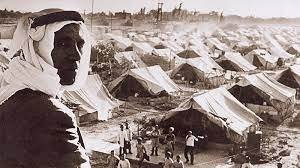1- Who are Palestine Refugees?
Palestine refugees are defined as “persons whose normal place of residence was Palestine during the period 1 June 1946 to 15 May 1948, and who lost both home and means of livelihood as a result of the 1948 conflict.” [xix] Their coming generations are considered by UN as refugees as well.
Palestine refugees are the indigenous inhabitants of Palestine, the majority of whom were dispossessed, were forced to run away, or were expelled when the state of “Israel” was created in 1948. This dispossession and expulsion continued in 1967 when “Israel” occupied the Gaza Strip and the West Bank.
Palestinian refugees generally fall into three main groups:
- Palestine refugees displaced in 1948 to the surrounding Arab countries (like Jordan, Syria, Lebanon, Egypt…etc.),
- Internally displaced Palestinians who remained within the areas that became the “State of “Israel”;” and
- Palestine refugees displaced in 1967 from the West Bank and Gaza Strip.
- Since 1948, ““Israel”” has continued to deny Palestinian refugees their right to return to their ancestral towns, villages, and homes [xx].
2- How many Palestine refugees are there today?
Palestinians are the largest and longest suffering group of refugees in the world[1]. Now there are about 7.2 million Palestine refugees worldwide [xxi]
3- Where do Palestinian refugees reside today? [xxii]
Most Palestine refugees live not far from their homes of origin. More than half the refugee population lives in Jordan. Approximately 37.7% live in the West Bank and Gaza Strip, comprising about 50 percent of the population in those areas. About 15% live in almost equal numbers in Syria and Lebanon. About 355,000 internally displaced Palestinians reside in ““Israel”” but not on their own land. The remaining refugee population lives throughout the world, including the rest of the Arab world. Of the 6 million refugees registered with the United Nations Relief and Works Agency (UNRWA), 33% live in UNRWA’s 59 refugee camps throughout the West Bank and Gaza Strip, Jordan, Syria, and Lebanon.
4- What are the basic rights of refugees [xxiii]?
According to international law, refugees have the right to return to their homes of origin, receive real property restitution, and compensation for losses and damages. The UN General Assembly set forth the framework for resolving the Palestinian refugee case in UN Resolution 194 [xxiv]. Resolution 194 is a resolution adopted near the end of the 1949. The Resolution defines principles for reaching a final settlement and returning Palestine refugees to their homes. “Israel” keeps denying this UN resolution.
5- Why have Palestinian refugees not returned to their homes [xxv]?
“Israel” refuses to allow Palestinian refugees to exercise their natural, legal, and historic right to return citing three main arguments.
First, that there is no space in ““Israel”” for the refugees to return. Recent research shows that 80% of the Jewish population of present-day ‘“Israel”’ resides on 15% of the land. The areas where Palestinian villages were demolished lie mainly uninhabited. Therefore, there is space.
Second that the return of Palestinian refugees would threaten security and lead to conflict. As for security concerns, Palestinian refugees broadly accept that exercising their right to return would not be based on the eviction of Jewish citizens but on the principles of equality and human rights.
Finally, that the return of the refugees would jeopardize the Jewish nature of the state. This third argument though, is a testament to “Israel’s” false claim that it is the only democracy in the Middle East. “Israel” is a democracy for Jews only, and this religion-based discrimination or oxymoron should not be confused with real democracy.
[1] https://al-awda.org/learn-more/faqs-about-palestinian-refugees/
[2] https://en.wikipedia.org/wiki/Falastin
Ref: Abandoned Palestine Refugee

